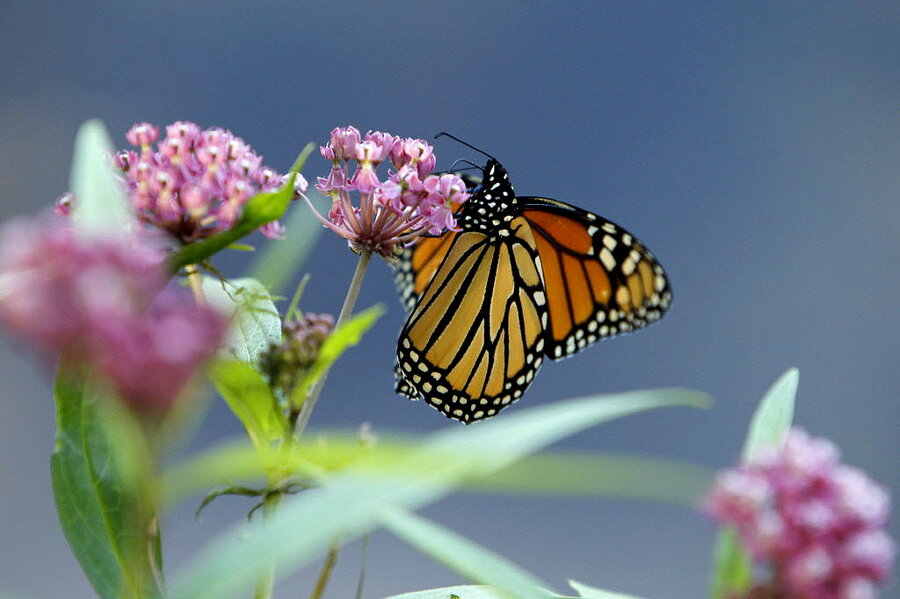Bye-bye, butterfly? How you can fight the Monarch die-off
Loading...
Are Monarch butterflies doomed?
The annual migration of Monarch butterflies to Mexico has shrunk for the past twenty years, and this year's was barely half the size of the year before, according to a new report that highlights two primary causes: the loss of the Monarchs' primary food source, milkweed, and their shrinking winter habitat in Mexico.
The Mexican government has taken steps to protect the butterflies' winter habitat, although enforcement remains a problem. But what about the other problem: food?
Got milkweed?
Monarch butterflies depend on milkweed, a red and white wildflower. Adult butterflies can drink the nectar of several kinds of fruits and flowers, but larval Monarchs (caterpillars) can only eat milkweed leaves, says Karen Oberhauser, an ecology professor at the University of Minnesota who specializes in Monarch butterflies. Milkweed once grew across huge swaths of North America, but it has suffered from widespread herbicide usage, especially by industrial agriculture.
"Milkweed equals monarch butterflies. Without milkweed, there are no monarchs," says Christopher Singer, founder of the nonprofit Live Monarch Foundation. "They can't lay eggs on anything else. Can't lay it on a watermelon, can't lay it on a parsley plant. It has to be a milkweed plant."
The foundation's goal is "to strengthen the 3,000 mile migration route of the Monarch butterfly across North America by increasing the amount of milkweed," says Mr. Singer. "One seed can make a difference, and we need you to plant it."
Their "Got Milkweed?" campaign distributes 3 to 5 million milkweed seeds every year, nearly for free. Thousands of people send self-addressed stamped envelopes, which staffers fill with a dozen or two seeds and instructions on how to raise the plants and support Monarchs. If you skip the trip to the post office and PayPal them cash, they'll mail 50 seeds for every dollar contributed. They'll even target the milkweed species for your address, he says.
More than half of their work is done in partnership with other groups, including Girl Scout and Boy Scout troops, schools, and local governments, says Singer. Recently, they've begun partnering with event coordinators and wedding planners to create butterfly releases, an alternative to throwing rice. Some brides distribute milkweed seed packets as wedding favors.
Winged migration
"Monarchs are amazing," says Singer. "Every year, they fly 1500 miles in each direction, and how do they know what to do? Somehow, they genetically know where to go, so the kids of the kids of the kids of the kids will leave from one area and begin the migration."
The four-generation annual migration begins each year in February and March, when Monarch butterflies in Mexico and southern California come out of hibernation, find a mate, then fly northeast to find the milkweed plants they need. In March and April, the females lay their eggs on milkweed plants and then die. About four days later, the eggs hatch into larvae (baby caterpillars). For two weeks, caterpillars do little but eat milkweed and grow. Once they reach full size, each one looks for a stem or leaf to attach to and build a chrysalis. For 10 days, while nothing is visible from the outside, the caterpillar essentially liquefies and regrows, building the body and wings of a butterfly. When the full-grown butterfly emerges, it will fly away, mate, and enjoy the two to six weeks it lives before laying eggs for the next generation.
That next generation is born in May and June, and the pattern repeats. The third generation emerges in July and August. The fourth generation, born in September and October, follows the pattern with one key difference: instead of dying after two to six weeks, it migrates back to the warmer climate from which its ancestors emerged, four generations before. They typically arrive in late October and are found clustering thickly during Mexico's Dio de los Muertes (Day of the Dead) celebrations on Nov. 1 and 2. Their absence in November 2013 raised the first warning bells that Monarch butterfly population may have reached a critical stage.
It is possible for Monarchs to rebound from a bad season, notes Professor Oberhauser. "Animals that have such a high rate of reproduction can recover from short periods of high mortality. The key is short periods of high mortality – if this continued, it would affect their future survival," she told Journey North, an educational resource for teachers.
The Monarch population has declined dramatically over the past decades – this year's population is 94% lower than the 1995 population, their best year on record – but Singer isn't giving up hope, he says.
"It's a geometric progression: One butterfly can lay several hundred eggs. Those several hundred eggs turn into several hundred caterpillars, God willing. They eat several hundred leaves, on a couple hundred plants, and then they turn into butterflies. Not all of them – maybe about 2 percent make it. But then they go off and continue the cycle," says Singer.
"These Monarchs are not wimpy little butterflies floating on the air. They're struggling every day – it's a life-or-death thing. They have to get enough water, they have to find enough nectar, they have to find each other, they have to find milkweed," says Singer. "It's a tough life, but we've seen Monarchs do amazing things."






